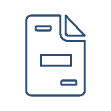Table of Contents
Understanding How a Line of Credit Works
A line of credit (LOC) is a type of flexible loan issued by a financial institution, such as a bank or credit union. Similar to a credit card, a line of credit comes with a predetermined maximum amount of money that you can access as needed to pay for unexpected expenses or other financial obligations. This maximum amount is referred to as the credit limit.
One of the many advantages of securing a line of credit is that you can typically borrow as little or as much as you need to, as long as you don’t exceed the credit limit. Just like purchases made with a credit card, a personal line of credit allows you to access your funds on demand, allowing you to have the flexibility of choosing when the money is borrowed while your account is in good standing.
With a revolving line of credit, you can continuously withdraw money up to your credit limit and pay off your balance. You will only pay interest if you draw from your line of credit, and you can choose to pay the money back immediately or pay in increments over time. Once you incur a balance on your line of credit, interest may start to accrue immediately. If you carry a balance over to the next month, you are required to pay at least the minimum payment amount.
In terms of accessing your available funds, you may have the option to transfer the money directly into your checking account. In many cases, a financial institution will provide you with a chip card that is linked directly to your LOC account.
Secured Vs. Unsecured Lines of Credit
Lines of Credit can be both secured and unsecured credit products. An unsecured line of credit is not guaranteed by an asset, and the interest rates will likely be higher than the rates for a secured line of credit. Although personal lines of credit are typically unsecured, you can apply for a secured line of credit and use your qualifying asset as collateral for funding.
| Secured Line of Credit | Unsecured Line of Credit |
| Guaranteed by Collateral (i.e. Vehicle or Dwelling, etc.) | No Collateral is Required |
| Higher Credit Limits May Be Available Due to The LOC Being Secured by an Asset | More Challenging to Obtain Approval, Especially With a Poor Credit Score |
| If the Borrower Does Not Keep Up With Payments, the Lender May Enforce its Rights and Recover the Collateral | Generally Come With Higher Interest Rates Than Secured Lines of Credit |
Besides a personal line of credit, other types of LOCs include the following:
- Business Line of Credit: To qualify for a business line of credit and manage short-term cash flow issues, a business must meet the lender’s application criteria. This typically includes the applicant meeting the applicable credit requirements and proving that the business earns a qualifying amount of annual or monthly revenue. In many cases, an applicant must provide documentation showing that their business has been operating for at least 6 months. A business line of credit can be secured by liquid assets to obtain more favorable rates and terms than unsecured lines of credit.
- Home Equity Line of Credit (HELOC): This credit line is secured by the value of your home and is generally used to finance home renovations or consolidate credit card debt.
If you have no assets to pledge as collateral and you have a fair credit rating or lower, then you may want to consider adding a cosigner with a high credit score when applying for a line of credit.
Generally, the higher your credit score, the more likely you are to receive better loan terms. However, that may not always be the case. The Consumer Financial Protection Bureau (CFPB) released a report to consumers based on the results of their most recent Terms of Credit Card Plans Survey. In this report, the survey data revealed that regardless of credit rating, large banks are charging higher credit card interest rates and offering worse terms than small banks and credit unions. Shopping around for new credit at smaller banks and financial institutions may be useful to ensure you obtain the most favorable terms you can.
How Can I Use a Line of Credit?

You can use the money you withdraw from an LOC to finance home renovations, medical treatments, or financial emergencies and projects that have unpredictable costs. Generally speaking, you can use the funds from a personal line of credit for any personal or household expense, whereas the proceeds from a business line of credit must be used for business expenses.
Whatever you decide to do with your money does not matter as much as how you pay it back. By carrying a balance on your LOC and not paying it off before the billing cycle ends, you are increasing your credit utilization ratio. Having a high credit utilization ratio can negatively impact your score, so it is imperative that you pay your debts on time and work towards keeping your total credit utilization ratio under 30%.
What Are the Advantages and Limitations of a Personal Line of Credit?

A personal line of credit is a flexible way to access the funds needed to solve a variety of financial situations. The APR and credit limit for a personal LOC can compare favorably with those of credit cards. Whether you are funding a home renovation or simply accessing extra money to handle an unexpected expense, a line of credit is a valuable resource to have in your financial toolkit. Although there are benefits to accessing a personal line of credit, there are limitations that you should be aware of, including the following:
Lack of Rewards
While using a line of credit is similar to using a credit card, you will miss out on the opportunity to earn travel miles or cashback rewards on your purchases.
Unpredictable Interest Rate
Unlike most personal loans or title loans, a line of credit typically comes with a variable interest rate. Generally, a variable rate makes it difficult to predict the repayment process since payments may increase when interest rates go up, so consider that disadvantage before you submit an application.
Fees Associated With a Line of Credit
The following types of fees can be encountered when using a line of credit:
- Set-up and maintenance fees: Financial institutions such as banks and credit unions typically charge a fee for opening or maintaining a line of credit. These fees may be referred to as set-up fee, annual fee, or monthly maintenance fee in the account opening documents.
- Penalty fees: Just like personal loans and credit cards, if you withdraw money through an LOC and do not keep up with your payments, you can expect to have late fees added to your account when you miss your payment. If a payment you’ve submitted is returned due to insufficient funds in your bank account, you can expect to be charged a returned payment fee.
- Transaction fees: Some line of credit providers charge a transaction fee for each withdrawal you make against your credit limit. This fee can be a fixed dollar amount, a percentage of the cash advance, or a combination of the two.
Not for Everyday Purchases
A personal line of credit and a credit card are similar types of revolving credit, but an LOC may not be the most advantageous option for everyday purchase because there is no feature to earn rewards, and because a credit card is much easier to use at the point of sale.
No Grace Period
Unlike credit cards, an LOC usually does not come with a grace period for purchases. As mentioned above, interest can start to accrue immediately after you draw from your LOC.
Learning How to Manage a Line of Credit
Just like credit cards, a common pitfall associated with a line of credit is the risk of getting trapped in a cycle of debt. In layman’s terms, the dangers of an LOC occur when you borrow money that you cannot afford to pay back. Making just the minimum payment every month takes care of a portion of what you owe, but interest will continue to accrue if you don’t pay off your entire balance.
Avoid the temptation to access the entire amount you are approved for and only take what you need. For example, if you are approved for an LOC of $10,000 and you only need $5,000 to fully renovate your bathroom or fund another project, do not take out $10,000 and spend the remaining amount on items you can’t realistically afford to pay back. Having a budget plan in place when taking out an LOC is the first step towards managing your line of credit and securing financial stability. Do not treat it like a rainy day fund. Instead, view an LOC like a credit card and reserve it for pressing financial situations that you handle with purpose!
According to Wilbert van der Klaauw, an economic research advisor at the New York Fed, credit card delinquencies are still rising above pre-pandemic levels. This is a pressing concern, as the largest demographic experiencing financial distress is reportedly younger borrowers and lower income households. Regardless of your age or economic background, understanding the intricacies of financial literacy and responsibly managing your finances are the keys to staying on top of your debt obligations.
Line of Credit Vs. Other Borrowing Options
A line of credit is often compared to a personal loan, which is a type of unsecured loan that is offered by banks, online lenders, and credit unions. With a personal loan, a qualified borrower will receive a singular lump sum that they will pay in equal installments over a set period of time. Personal loans can be ideal for borrowers who need larger amounts of money upfront and prefer to have a fixed interest rate.
And while a personal loan may have a fixed interest rate, a personal line of credit usually does not. Instead of paying in predictable monthly installments like you would through a personal loan, the payments for your LOC can fluctuate depending on your balance and the current interest rate.
If you are not eligible for a personal loan or a line of credit due to your lack of credit history or poor credit, another borrowing option to consider is a title loan. Title loans are known for catering to individuals with bad credit. Like other secured loans, they come with a more flexible and convenient application process. With ChoiceCash title loans serviced by LoanMart, a qualified borrower can expect competitive interest rates and access up to $15,000 by pledging their car as collateral for the loan.1
Ultimately, the decision to apply for a line of credit, a personal loan or a title loan is completely dependent on your preferences and financial situation.1
Faqs About Applying for a Line of Credit
Listed below are some of the most commonly asked questions about applying for a line of credit:
How Much Can You Access Through a Line of Credit?
Typically, the amount you can access through a line of credit is influenced by several factors, including the type of LOC, your creditworthiness, your debt-to-income ratio (DTI), and the lender’s policies.
How Do You Pay Back a Personal Line of Credit?
Repaying a personal line of credit is similar to repaying a personal loan or any other type of credit. Below are the options you will typically have to pay back a personal line of credit:
- Online Payments
- Setting up Automatic Payments From a Checking Account
Can I Use My Personal Line of Credit to Pay Bills?
Once you are approved for a line of credit, you can use your funds to pay your mortgage, settle unpaid bills, or handle any other type of personal expense.





